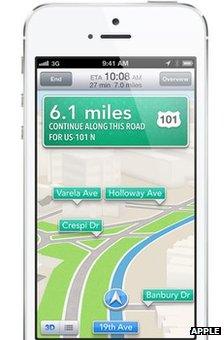Apple iPhone 5 unveiled with taller screen and 4G
- Published
- comments
Rory Cellan-Jones: 'There is big competition out there in the smartphone world...let battle commence.'
Apple has unveiled a taller, 4G-enabled iPhone at an event in San Francisco.
The device's new size allows it to display an extra row of app icons on its home screen.
The firm said it was 18% thinner and 20% lighter than the iPhone 4S. However, it does not feature an NFC (near field communication) chip to allow it to make touchless payments.
Apple said the handset would work on Everything Everywhere's (EE) 4G LTE network in the UK.
The news is likely to give EE - which runs the local Orange and T-Mobile services - an advantage against its rivals which will not launch the higher-speed data service until 2013.
"I think it's obviously what the other networks feared would happen," said Matthew Howett, a telecoms analyst at Ovum.
"The question will be how many non-EE customers make the switch."
Apple said the handset would ship on 21 September.
Faster speeds
The new screen offers a 16:9 ratio, matching that of widescreen televisions.
But its 4in (10.2cm) size remains smaller than rival displays used by Samsung, Nokia, Motorola, LG, HTC and Sony's flagship models.
Phil Schiller - Apple's vice president of worldwide marketing, who unveiled the device - said existing apps would be shown with black borders until developers updated their products.
The handset also features a new Apple-designed chip, called the A6. Mr Schiller suggested this made it twice as powerful as the earlier model.
The camera is an eight megapixel model - the same as in the iPhone 4S, and a lower specification than LG and Sony's most recent devices.
However, Mr Schiller said the equipment and associated software meant the iPhone would create better photographs in low light than before.
The handset also uses a new, smaller, socket for its charger. This means owners will need to use an adapter to plug the device into existing speakers and other equipment. The adapter is listed as being £25 on Apple's site, external.
The handset does not offer wireless charging like Nokia's Lumia 920.
It will be sold with either 16 gigabytes, 32GB or 64GB of storage. The basic model will be sold for £529 in the UK, but the figure will be lower if bought with a network contract.
In addition to launching the new model, Apple will continue to ship versions of the iPhone 4S and the iPhone 4, but is phasing out 2009's iPhone 3GS.
Reworked iTunes
Despite the fact that the iPhone 5 lacks several features found on its rivals, one analyst at the presentation thought it would prove popular.
"There are unprecedented levels of pent-up consumer demand that will ensure it eclipses all previous iPhone launches," said Ben Wood from CCS Insight.
"Newly rebranded UK network EE will be delighted by the fact the iPhone 5 supports the right flavour of 4G LTE technology."
However, another industry watcher thought that the firm might have made a mistake by rejecting new tech in order to make the model thinner.
"The decision to omit NFC in the iPhone 5 could cost Apple," said Fred Huet, managing director at Greenwich Consulting.
"It is just a matter of time before the smartphone replaces the plastic card, and by skipping this technology, Apple may have missed a valuable opportunity to take the lead in this market.
"With over 400 million active credit card accounts on file, Apple had a prime opportunity to convert its customers using a sleek mobile payment system tied to the iPhone."

Apple-designed maps become available on iOS 6 from 19 September
Apple also announced iTunes, its media player and store for Macs and PCs, was being redesigned and would be released in October, and it also unveiled new iPods.
Big earner
The latest iPhone's performance will prove critical to Apple's fortunes.
According to the firm's most recent earnings report the iPhone and related services and accessories accounted for 52% of $120bn (£74bn) total net sales, external over the nine months running up to July - 98 million handsets were sold in that time.
That has helped boost its share price to new heights. At the end of last week the firm was worth $637.85bn based on its share price. That was the highest such valuation to date if you do not adjust Microsoft's 1998 figure for inflation.
However, competition is intensifying. While Apple's margins may be wider, Samsung's handset sales are growing at a faster pace.
According to data from IDC the South Korean firm accounted for 43.6% of the Western European smartphone market between April and June compared to Apple's 19%.
The figures will have been skewed by the fact that Samsung offers more models and the Galaxy S3 was a newer device than the equivalent iPhone, but one industry watcher said the rivalry could intensify over coming months.
"Samsung has been very efficient pushing and promoting their devices offering the biggest commissions to sales people," Francisco Jeronimo, research manager at IDC, told the BBC.
"The momentum they are gaining with consumers is very high and people see it as a very innovative brand - and customers are clearly looking for innovation rather than just refinements. Samsung will also be likely to make further gains by making price cuts before Christmas."
Apple's stock closed 1.4% higher.
- Published5 September 2012
- Published29 August 2012
- Published29 August 2012